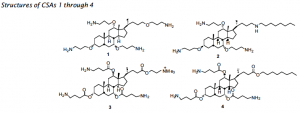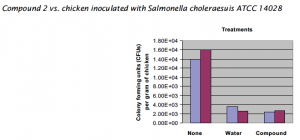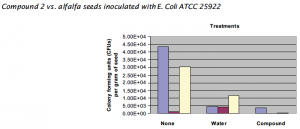Timothy W Winter and Dr. Paul B Savage, Chemistry and Biochemistry
Food-borne illnesses are a continuing problem in the US. According to figures from the Center for Disease Control, an estimated one million food-borne infections and 500 deaths occur each year associated with Salmonella. Also reported are the cases involving Escherichia coli O157:H7; the death toll is between 50 and 100 people every year. Currently, the only antibiotic approved for use in food in the US is nisin, a cationic peptide antibiotic (CPA) that is active against Gram-positive bacteria but not Gram-negative (including E. Coli and Salmonella).
Cationic steroid antibiotics (CSAs), developed in Paul B. Savage’s laboratories, have proven to be highly active, broad-spectrum antibacterial agents. The mechanism of action of CSAs is similar to that of many naturally occurring CPAs in that they selectively disrupt bacterial membranes without inducing the emergence of resistance strains of bacteria. The antimicrobial activities of CSAs depend largely on the hydrophobic chains that extend from the steroid nucleus; therefore, in order to effectively evaluate the abilities of CSAs to inhibit microbial growth in food, our team prepared four different compounds. The alterations consisted of attaching different hydrophobic chains to the steroid scaffold (see figure below).
Initial screening determined which of the four compounds would be most effective at inhibiting microbial growth in chicken breasts and alfalfa sprouts. To determine the most effective compound against bacteria in the presence of chicken, our group modified the minimum inhibitory concentration (MIC) assay: the extra variable consisted of adding pieces of chicken breasts. It was observed that compound 2 was more effective at the lowest concentration (100ìg/mL) than the other compounds, while in the presence of chicken (5g).
In subsequent experiments, compound 2 was used as a treatment for artificially inoculated chicken breasts; water served as the control treatment. Several trials were performed, allowing our group to review the best method of manipulating the variables: temperature of treatment, concentration of treatment, and time of treatment. The most effective treatment held these variables: temp, 55oC; concentration, 100ìg/mL; time, 1 minute. Replication (2 times) allowed our group to chart compound 2’s ability to inhibit microbial growth (see graph below).
Treatment of chicken breasts with compound 2 (100ìg/mL) at 55oC for 1 min is comparable to treating with water under the same conditions (1 log reduction). Subsequent experiments have shown ability of compound 2 to drop CFUs by 2 logs, but results have not been replicated. Our group will continue to study CSAs ability to inhibit microbial growth in chicken breasts in the following ways: observe CFU counts on chicken breasts that have been inoculated, then treated, and later stored for 2 weeks at refrigerated temperatures; and observe CFU counts on chicken breasts that are first treated with compound before inoculation.
The next phase required an initial screening to determine which of the four compounds would be most effective at inhibiting microbial growth in alfalfa sprouts. We are currently still in the initial screening, but results have been promising for compound 2 (others have yet to be tested).
Compound 2 was used as a treatment of artificially inoculated alfalfa sprouts; water served as a control. Two trials were performed, and our group considers the most effective treatment to contain these variables: temp, 37oC; concentration, 100ìg/mL; time, 10 minutes. Replication (3 times) allowed us to chart compound 2’s inhibition of microbial growth (see graph below).
Treating seeds with compound 2 (100ìg/mL) at 37oC for 10 min reduces CFUs by almost 2 logs. These are only initial results and furthering testing will include the following: increasing the temp of treatment to 55oC; and dissolving our compound in hypochlorite solution (2000mg/mL). I will present a poster of my final research findings at a Food Science Symposium in Wisconsin.



